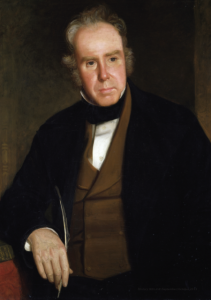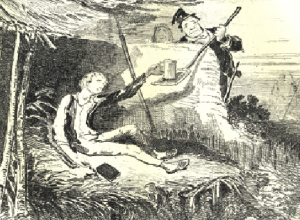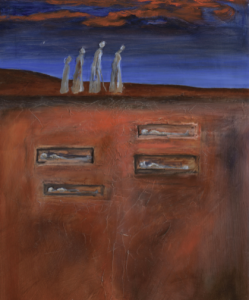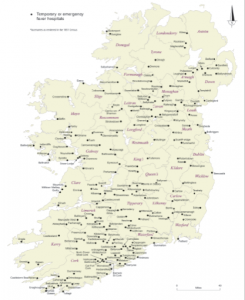William Carleton: famine, disease and Irish society
Published in 18th–19th - Century History, Features, Issue 5 (September/October 2013), The Famine, Volume 21
The author William Carleton—described by W.B. Yeats as ‘a great Irish historian’. (National Gallery of Ireland)
W.B. Yeats described the author William Carleton (1794–1869) as ‘a great Irish historian’. According to Yeats, ‘the history of a nation is not in parliaments and battlefields but in what the people say to each other on fair-days and high days, and in how they farm, and quarrel, and go on pilgrimage’, and these were the things that Carleton recorded. In his introduction to the ‘new edition’ of his Traits and stories of the Irish peasantry, which appeared in 1843, Carleton explained that he had endeavoured ‘to give a panorama of Irish life among the people . . . their loves, sorrows, superstitions, piety, amusements, crimes and virtues’. He had ‘painted them honestly’, he said, ‘and without reference to the existence of any particular creed or party’. In his novels and sketches of peasant life in Ireland in the first half of the nineteenth century Carleton depicted the living conditions and living standards of the poor, and other social realities such as the relationship between poverty and illness, the prevalence of disease, and the recurring famines and accompanying fever epidemics that were such a feature of Irish life.
Corrigan’s Famine and fever as cause and effect in Ireland
The Black Prophet, which was subtitled A tale of Irish famine, was serialised in the Dublin University Magazine between May and December 1846 and published in book form early in the following year. The work was based on the author’s experience of famine between 1817 and 1819 and again in 1821 and 1822. Dr Dominic Corrigan’s influential pamphlet Famine and fever as cause and effect in Ireland also appeared in 1846 and it, too, was empirically based on earlier famines and fever epidemics. Corrigan’s central thesis was that fever was the inevitable consequence of famine; all previous Irish experience had shown that famine would be accompanied by a lethal outbreak of the disease.
Carleton’s portrayal of fever in The Black Prophet was based on Corrigan’s pamphlet, which had attracted considerable attention on publication. The pamphlet was widely noted and widely reviewed, largely because Corrigan’s argument was controversial. This was long before the germ theory of disease was formulated and disease causation was still speculative. In a footnote that runs to almost two and a half pages of text, Carleton reproduced several extracts from Corrigan’s work, including the final paragraph in which Corrigan compared the relative impact of typhus fever and Asiatic cholera, which had appeared in Ireland for the first time in the early 1830s and caused unprecedented consternation and panic. According to Corrigan, fever was far more lethal and destructive than cholera or any other infectious disease:
‘Cholera may seem more frightful but it is in reality less destructive. It terminates rapidly in death, or in as rapid recovery. Its visitation too is short, and it leaves those who recover unimpaired in health and strength. Civil war, were it not for its crimes, would be, as far as regards the welfare of a country, a visitation less to be dreaded than epidemic fever.’
Corrigan’s Famine and fever as cause and effect in Ireland and Carleton’s The Black Prophet had the same fundamental political purpose: to serve as a warning to the government and its administration in Ireland of the inevitable pestilential consequences of the evolving famine situation. As Carleton wrote in his lengthy footnote, Corrigan’s pamphlet ‘ought to be looked on as a great public benefit’; it conveyed ‘most important truths to statesmen’.
Ireland 1817–19: ‘one vast lazar-house’

Jemmy McEvoy in his ‘fever hut’ from Carleton’s ‘The poor scholar’, one of the tales in Traits and stories of the Irish peasantry. Jemmy was placed on some straw in this structure, and food and drink were passed to him by means of a pitchfork and a long-shafted shovel, which was the custom of the time.
In The Black Prophet Carleton stated that during the famine and fever epidemic of 1817–19 ‘the number of those who were reduced to mendicancy was incredible’, an observation corroborated by numerous contemporary accounts. He compared Ireland during these years ‘to one vast lazar-house, filled with famine, disease and death. The very skies of heaven were hung with the black drapery of the grave’, he wrote. Carleton commented on the ubiquity of ‘hearses, coffins, [and] long funeral processions’. He noted the constant pealing of church bells and the roads that were ‘literally black with funerals’.
Carleton’s language and imagery echoed those of the young Dr Robert James Graves, who had been sent to Galway as an emergency physician during the famine of 1822. Graves noted ‘the scrupulous performance of wakes, the cries and lamentations of those who thronged after funerals, the tolling of the death-bell, which was always done with becoming diligence’, all of which lent the town ‘a strikingly mournful appearance’.
Popular fear of infection
One of the features of Graves’s report—and it is one that occurs time and again in Carleton’s fiction—is the popular fear of infection, a fear that intensified on the appearance of any one of the deadly epidemic diseases that plagued Ireland periodically in the first half of the nineteenth century. Graves described the ‘consternation’ he encountered when he arrived in Galway in late September 1822, where, he noted, the common topics of conversation were the sick and the dead. Ties of blood, friendship and hospitality were frequently broken by the same dread of contagion, Graves reported, and the infected were either turned out of their cabins or abandoned within to their own devices.
Carleton captured the popular reaction to communicable diseases like typhus fever in The Black Prophet and in many of the tales that make up Traits and stories of the Irish peasantry. There are resonances of Graves in the following extract from The Black Prophet:
‘The dreadful typhus was now abroad in all its deadly power, accompanied, on this occasion, as it always is among the Irish, by a panic, which invested it with tenfold terrors. The moment fever was ascertained, or even supposed, to visit a family, that moment the infected persons were avoided by their neighbours and friends as if they carried death, as they often did, about them, so that its presence occasioned all the usual interchanges of civility and good-neighbourhood to be discontinued.’
Later in the same work he wrote: ‘Such as had typhus in their own families were incapable of attending to the wants or distresses of others, and such as had not, acting under the general terror of contagion which prevailed, avoided the sick houses as they would a plague’.
This is authentic. It is an accurate portrayal of Irish social realities in the first half of the nineteenth century. Fear, dread, mass panic and hysteria were features of all outbreaks of fever in Ireland, and of other diseases also. One possible explanation is fear of the unknown. People did not know how these diseases were caused and, by extension, how to cure them, and they feared what they did not know and could not control. What they were very much aware of was the impact and consequences of diseases like fever. If these diseases did not kill their victims, they often reduced them to pauperism.
The Irish people had an unrivalled knowledge of fever, its symptoms and its consequences. They were empirically aware that the disease was contagious, and fear of infection drove them to quarantine fever victims. There were two main ways in which isolation was attempted, a process that was largely dictated by the circumstances of the affected families. The middle and upper classes, with better housing and superior domestic arrangements to the poor, attempted to isolate the infected within their homes. A common practice appears to have been that described by a County Kilkenny doctor in 1844. He reported that when fever appeared in the homes of ‘comfortable farmers’, the door of ‘the sick room’ was ‘built up with sods, and a hole made in the back wall, through which the doctor must scramble in the best way he can upon all fours into an apartment which is almost invariably dirty, dark and damp’. He added that such contortions were invariably fruitless, as domestic segregation did little to check the spread of disease.
‘Fever huts’
The poor attempted to isolate fever victims in shelters called ‘fever huts’. These usually consisted of a few stakes, covered with long sods called ‘scraws’ and a small portion of straw or rushes. These wretched structures were hastily thrown together at the side of a road, the corner of a field or the verge of a bog. In the 1830s a County Kildare doctor informed a parliamentary commission inquiring into the circumstances of the Irish poor, the so-called Poor Inquiry, of a fever patient he had found lying on some straw in a ditch. ‘It could not be called a hut’, he said, ‘because it had only two sides, the back of the ditch forming one and some straw and furze tied together formed the other. This was removable and changed to whatever side the wind blew from.’ A visitor to County Fermanagh in 1839 encountered five instances ‘where the inmates of fevered hovels had fled to the roadside and struck up a kind of wigwam, composed of an upright stick, at the back of a ditch, and a lock of straw’.
In ‘The poor scholar’, one of the tales in Traits and stories of the Irish peasantry, Carleton describes the experiences of Jemmy McEvoy, who had contracted fever. ‘The early symptoms of the prevailing epidemic were well known . . . The Irish are particularly apprehensive of contagious maladies. The moment it had been discovered that Jemmy was infected, his school-fellows avoided him with a feeling of terror scarcely credible.’ According to Carleton, the infected schoolboy was avoided ‘like a Hebrew leper of old’. Eventually, a group of agricultural labourers discovered the dazed and barely conscious Jemmy. They, too, were afraid of the disease but after some deliberation agreed to help him because, in the words of one of their number, ‘there’s a great blessin’ to thim that assists the likes of him’. ‘Let us help him!’ exclaimed another, ‘for God’s sake, an’ we won’t be apt to take it thin!’ The labourers built ‘a little shed’ for Jemmy on the side of the public road, ‘a shed formed of a few loose sticks covered over with “scraws”, that is the sward of the earth pared into thin stripes’. The poor scholar, Jemmy, was placed on some straw in this structure, and food and drink were passed to him by means of a pitchfork and a long-shafted shovel, which, again, was the custom of the time. The peasantry resorted to this stratagem in order to avoid coming into personal contact with the infected individual.
The sentiments and mode of expression in this story resemble the evidence recorded in the Poor Inquiry relating to the provision of charity to beggars and vagrants—the Poor Inquiry, conducted in the mid-1830s, was almost contemporaneous with Traits and stories of the Irish peasantry. A contributor to the inquiry, William King from Headford, Co. Galway, stated: ‘When I give, I do so for the good of my soul, the honour of God, and for their benefit’. John Griffin, a weaver from County Galway, informed the inquiry: ‘I give, recollecting that I have another place to go to, where, if I give alms, I will receive fourfold reward’. A freeholder from the same county put it even more succinctly when he stated that charity was ‘the best way to heaven’.
Book dedicated to Lord John Russell
Carleton captured the vernacular, the popular voice that is often missing from the historical record—hence his importance for historians. But Carleton was more than a social chronicler; The Black Prophet: a tale of Irish famine in particular resonates with political sentiment. Carleton dedicated this work to Lord John Russell, prime minister of Great Britain and Ireland. He acknowledged that Russell and his predecessor, Sir Robert Peel, were ‘sincerely anxious to benefit’ Ireland, but he added in his dedicatory preface that
‘. . . the man who, in his ministerial capacity, must be looked upon as a public exponent of those principles of government which have brought our country to her present calamitous condition, by a long course of illiberal legislation and unjustifiable neglect, ought to have his name placed before a story which details with truth the sufferings which such legislation and neglect have entailed upon our people.’
Carleton assured the prime minister of the authenticity of the facts and circumstances depicted in his book and expressed the hope that Russell would prove to be ‘a friend’ of Ireland—a forlorn hope, as the events of 1847 and the following years were to show. The Black Prophet is a record of the passing of a peasant way of life, of a society that was utterly changed by the Great Famine. In his portrayal of famine and fever, and much else besides, Carleton was, as Yeats noted, a historian of his people. HI
Laurence M. Geary lectures in Irish history at University College Cork.
Further reading
Autobiography of William Carleton (London, 1896; rev. edn London, 1968).
W. Carleton, The Black Prophet: a tale of Irish famine (Belfast and London, 1847).
J. Robins, The miasma. Epidemic and panic in nineteenth-century Ireland (Dublin, 1995).


















